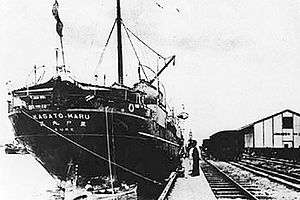Sadatsuchi Uchida
Sadatsuchi Uchida (内田 定槌, Uchida Sadatsuchi, born in 1865 in modern-day Kokura, Fukuoka Prefecture – June 2, 1942) was a Japanese diplomat. Assigned to postings in the United States and Brazil, Uchida was instrumental in facilitating improved Japanese trade relations and emigration to both countries.
Early life and diplomatic career
A law graduate of the Tokyo Imperial University, Uchida joined the Japanese Ministry of Foreign Affairs in 1889. He was appointed as an Eleve-Consul to Shanghai in 1890, Consul to Seoul in 1893 and in 1902 was reassigned to serve as Consul General in New York City.[1]
Rice cultivation in Southeast Texas
In 1902, Uchida toured the Gulf Coast region of the United States. At the time, overpopulation and the limited usable land for farming was affecting Japan.[2] In the United States, rice farming was still in its infancy, and local rice production was falling short of its full potential. Consul General Uchida met with officials from the Texas Governor’s office, business owners in Houston, and other community leaders who gave him confidence that the Japanese would be welcomed into the region. Uchida was impressed with the land of the Gulf Coast of Southeast Texas for its rice farming potential.[3]
Uchida's reports back to Japan of the agricultural conditions in Southeast Texas led to the migration of a number of Japanese businessmen and the development of rice cultivation in that region. Some of the better known of these migrants included Seito Saibara, who established a Japanese community near Webster, and Kichimatsu Kishi who would establish a colony in Orange County, Texas.[4]
Advocacy for Japanese emigration to Brazil

As emigration controls to the United States and Canada were gradually introduced, Uchida, in his new role as Japanese Minister Plenipotentiary in Brazil, successfully lobbied for an expansion of Japanese migration to that country.[5] In 1907, on Uchida's recommendation, the Brazilian and the Japanese governments signed a treaty facilitating Japanese migration. The first Japanese immigrants, 165 families, a total of 786 people, arrived in Brazil on 2 June 1908 on the Kasato Maru.[6] Mostly farming families destined to work in the coffee plantations, they had travelled from the Japanese port of Kobe via the Cape of Good Hope.[7]
Late career
Uchida also served in senior diplomatic posts as envoy to Sweden during the First World War and as High Commissioner to the Ottoman Empire.
Family home
Uchida's two story Shibuya, Tokyo home designed in 1910 by American architect James McDonald Gardiner, is preserved as a landmark feature of the Italian Garden Park in Yamate, Yokohama.[8]
Awards and recognition
Uchida received an honorary Doctorate degree from Rutgers University in 1905.[9]
References
- Minohara, Tosh (2014). The Decade of the Great War: Japan and the Wider World in the 1910s. Leiden: Koninklijke Brill. p. 268. ISBN 978-90-04-27001-5.
- "Archived copy". Archived from the original on 2006-05-17. Retrieved 2006-09-02.CS1 maint: archived copy as title (link)
- The Japanese Texans Archived 2006-09-01 at the Wayback Machine
- Handbook of Texas Online - JAPANESE
- Schuler, Friedrich (2010). Secret Wars and Secret Policies in the Americas, 1842-1929. University of New Mexico Press. p. 63. ISBN 978-0-8263-4490-8.
- Meade, Teresa (2004). A Brief History of Brazil. New York: Checkmark Books. p. 115. ISBN 0-8160-4672-7.
- Osada, Masako. (2002). Sanctions and Honorary Whites: Diplomatic Policies and Economic Realities in Relations Between Japan and South Africa, p. 33.
- Kawasaki, Satoko; Sayuri Daimon (October 22, 2010). "Diplomat's House". A Victorian Original on Yamate Bluff. Japan Times. Retrieved 21 May 2014.
- Raven, John (1909). Catalogue of the Officers and Alumni of Rutgers, New Brunswick, N.J., 1770 to 1909. Trenton: State Gazette Publishing Co. p. 356.